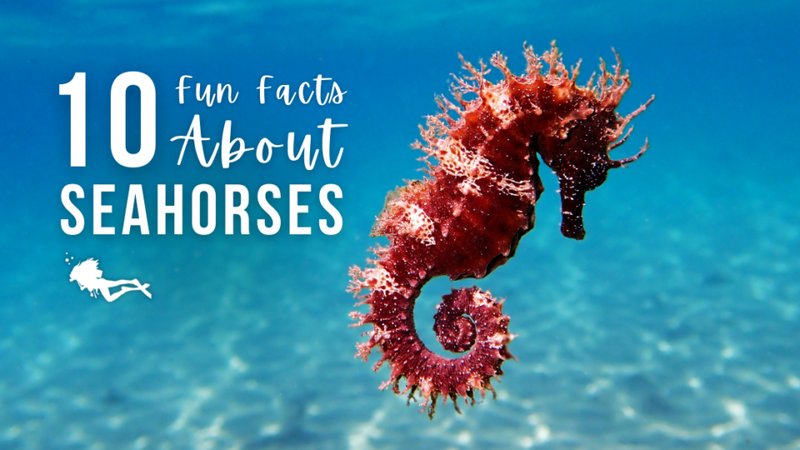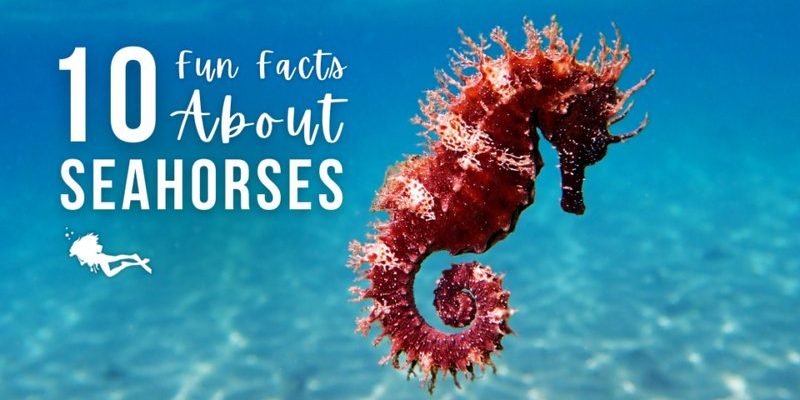
Imagine a creature that not only looks like it’s from a fairytale but also has some incredible traits that make it one of the most unusual animals in the ocean. From their reproductive habits to their peculiar swimming style, you’ll find that seahorses are filled with surprises. Let’s dive into the top 10 fascinating facts about these enchanting marine inhabitants.
1. Unique Swimming Style
Seahorses are not your typical fish. While most fish swim by moving their tails, seahorses have a different approach. They use a tiny dorsal fin on their backs to propel themselves forward. It’s almost like watching a butterfly flutter through the water! This unique swimming style means they’re not very fast swimmers, which is why they rely on their camouflage to avoid predators.
Additionally, seahorses can only move headfirst, which is quite different from other fish. This head-first swimming allows them to navigate through their environment while clinging onto seaweed or coral with their prehensile tails. Honestly, have you ever seen a creature that looks that adorable and quirky while moving?
2. Master of Camouflage
Camouflage is vital for their survival. Seahorses can change color to blend in with their surroundings, much like chameleons do on land. This ability helps them avoid predators like larger fish and birds. You might spot a seahorse that looks bright orange among coral, but give it a moment, and it could shift to a dull brown or green to hide from danger.
This color-changing ability isn’t just for hiding. It can also signify their mood. For example, when a seahorse is excited or stressed, it might change to brighter hues. Isn’t it fascinating how these little creatures have their communication style? You might be wondering how they manage to blend in so effectively; it all comes down to their unique skin structure, which allows for rapid color shifts.
3. Males Carry the Babies
Here’s the thing that really sets seahorses apart from most other species in the animal kingdom: male seahorses give birth! During mating, the female deposits her eggs into the male’s pouch, which is located on his abdomen. The pouch is like a small, safe environment where the eggs can develop.
After a few weeks, the male goes into labor, eventually releasing tiny, fully formed baby seahorses into the water. This fascinating reproductive role reversal is quite rare in the animal world. You can imagine how a male seahorse must feel carrying and birthing dozens of little ones—it’s a true testament to the wonders of nature!
4. Short Lifespan
Despite their captivating nature, seahorses have a surprisingly short lifespan. On average, they live for only about 1 to 5 years, depending on the species. This brief life can be attributed to their unique habitat and reproductive habits.
Many factors influence their lifespan, including predation, habitat loss, and changes in water temperature. Their vulnerability makes it essential to protect their environments. If you think about it, this short existence adds a layer of urgency to conservation efforts; we must work to ensure these amazing creatures can thrive.
5. A Variety of Species
You might be surprised to learn that there are about 70 different species of seahorses across the globe. Each species varies in size, color, and habitat preferences. For example, the common seahorse (*Hippocampus kuda*) is small and often found in shallow coastal waters, while the large seahorse (*Hippocampus abdominalis*) can grow up to 14 inches long!
Each species has adapted to its specific habitat, making them unique in their own way. This diversity might spark your curiosity: how do these different types of seahorses interact with their environments? Remember, despite their differences, all seahorses share the same adorable features that make them so beloved worldwide.
6. Vulnerable to Habitat Loss
One of the sad truths about seahorses is that they face significant threats due to environmental changes. Habitat destruction—a result of coastal development, pollution, and climate change—has greatly affected their populations. Coral reefs, mangroves, and seagrass beds are essential for their survival, but these habitats are being damaged more and more.
This vulnerability highlights the importance of conservation efforts. Organizations around the world work tirelessly to restore habitats and protect these charming creatures. When you think about it, supporting marine conservation not only helps seahorses but also protects the overall health of our oceans.
7. Slow Movers in the Ocean
Seahorses are known for their slow, almost whimsical swimming style. They can only move at a speed of about 1.5 kilometers per hour. This leisurely pace is largely due to their lack of a streamlined shape, which makes them more susceptible to being carried away by currents.
To combat their slow movement, seahorses often cling to objects with their tails, allowing them to stay in one place without expending much energy. Can you imagine being so well-adapted to your surroundings that you can just hang out and wait for food to come to you? It’s a unique lifestyle choice, for sure!
8. A Unique Feeding Method
Instead of hunting like many other fish, seahorses feed by sucking in tiny shrimp and plankton through their elongated snouts. They essentially “vacuum” their food from the water! This feeding method allows them to consume food quickly, which is crucial given their slower movement.
You might be wondering how they manage to find food amid the bustling marine world. Seahorses have excellent eyesight that allows them to detect prey from a distance. Plus, their camouflage helps them ambush unsuspecting food as it floats by. It’s like they’re using a stealthy approach instead of speed!
9. Lifelong Partners
Seahorses are known for forming strong pair bonds. Many species mate for life, engaging in intricate courtship dances to synchronize their movements. These dances can last for several days, during which they change colors and swim side by side.
Once they form a bond, they’ll often stay together for the breeding season. Isn’t that sweet? Their strong partnerships are quite rare in the animal kingdom and exemplify the intricate social behaviors found in nature. It’s a beautiful reminder of how connection can be fundamental, even in the underwater world.
10. Threats and Conservation Efforts
As lovely as seahorses are, they face significant threats due to overfishing, habitat destruction, and climate change. These pressures have led to a decline in some species, making them vulnerable to extinction.
Conservation efforts are in place to protect seahorse populations. Educating the public about their importance can help reduce demand for seahorses as pets and in traditional medicine. You might not realize it, but supporting sustainable practices can truly make a difference in their survival. Let’s work together to ensure that future generations can also marvel at these incredible creatures!
In conclusion, seahorses are not just adorable; they are fascinating animals filled with unique traits and behaviors. From their extraordinary reproductive roles to their whimsical swimming styles, they remind us of the wonders of nature. By understanding and protecting these enchanting creatures, we can help preserve the rich biodiversity of our oceans. Next time you come across a seahorse, take a moment to appreciate the little wonders that exist in our world!

